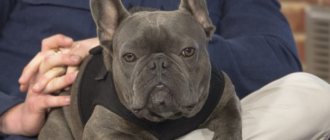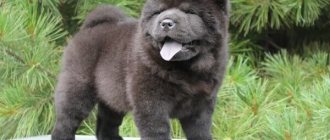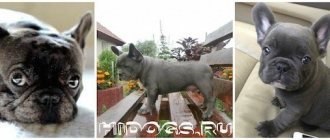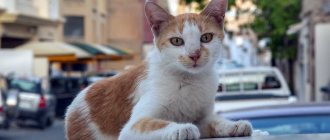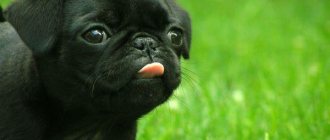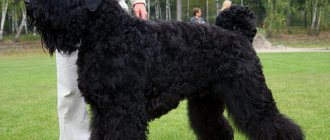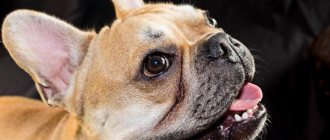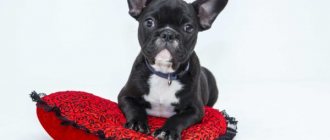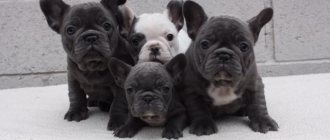Description of existing colors of French bulldogs. Disadvantages and defects according to the standard. Are there black and blue French bulldogs? How does color change with age?
The appearance of French bulldogs is very memorable. A wide head and muzzle, combined with a small nose and erect ears, create only positive impressions.
These dogs have clearly expressed emotions, even by their short tail you can understand their mood. Many people are used to seeing only brindle or bright French bulldogs. However, for 20 years now fawn color has been classified as permitted, and such puppies are considered exclusive, especially those with a black mask on the face.
Standard colors
The ICF system recognizes two types:
- Solid;
- Spotted.
The coat color is:
- • fawn;
- • brindle.
There are color combinations. For example, dark brindles on a fawn background. It is also customary to distinguish the degree of piebaldity (white spots):
- Limited spotted – white markings on chest, tips of paws;
- Medium spotting - half the coat is white;
- Absorbing spotting - the main background is white, but there are small splashes of color.
There are dogs with a completely white color, but it is undesirable. Black rims on eyelids and lips are required. The nose should also always be this color.
White coat is the absence of visible pigment in the coat. At the genetic level, she has color. In individuals of this breed with white spots of any size, light speckling is allowed.
Important: In fawn dogs, it is preferable to have a black mask. In brindles it occurs, but is often invisible due to the dark colors. Pied Bulldogs are allowed to have small white spots on the body.
Shades of fawn French bulldog
The fawn bulldog has variations in color.
There are shades (shown in the photo):
- Ginger
- Beige
- Coffee with milk
- Ashen
- Intense red
- Spotted (white spot on chest)
Fawn color
The color of the coat can vary from soft sand to red. The latter are also called deer. On the extremities, obvious lightening is possible. Previously, this color was considered non-standard, but already in 1994 the International Film Festival allowed it.
French bulldogs with fawn coats were always born in large numbers. With the development of genetics, such colors were no longer considered a sign of impure breeding.
If in distant ancestors pairs of brindle dogs had fawn spots or solid ones, then the puppies can inherit a solid color.
History of the breed
There is a story that the breed appeared during the reign of Chinese emperors. But there is no exact data confirming it.
Therefore, it is believed that the breed was bred in England, and then migrated to France.
It was more interesting to the French due to the fact that it appealed to the local elite.
Although earlier such dogs were owned by English dressmakers - bulldogs chased rats and guarded production.
But in France the breed was given a name that the dog still bears to this day . French bulldogs were first presented at a special exhibition in 1896.
And then they showed the Americans where the French bulldog became one of the most expensive and desirable dog breeds. They say that the price for one exceeded the cost of a luxury car.
French bulldogs appeared in Russia at the beginning of the 20th century . And this breed was also considered expensive and difficult to obtain. It was started by famous writers, poets, artists and politicians.
For example, it is known that Mayakovsky had a French bulldog, which Lilya Brik simply adored . The fawn French bulldog was officially recognized as a breed of this color only in 1995.
Species of tiger
It is interesting that all French bulldogs are fawn, and the coloring of brindle is variegated stripes on its background of varying intensity and size. The lines on the body come in different intensities. There are dogs that are almost black, but this is only visual. There are then some variegated hairs in the fur.
Divided:
- Fawn brindle – variegated stripes on a light background;
- Fawn-variegated – even distribution of brindle and fawn color;
- Heavily mottled - very dark, the main background is practically invisible due to the brindle;
- Reverse tiger is a new term meaning sparse stripes on a light background.
These French bulldogs look very impressive. The sizes of the transverse stripes are different, as is the brightness of the background. They appear on a red, sandy base and may be adjacent to white spots.
Disadvantages and vices
The ICF standard points out the disadvantages:
- Bright specks on brindle and fawn fur;
- White spots on the paws if the dog is solid color;
- Solid fawn individuals have a dark stripe along the back;
- Light claws.
Vices leading to disqualification from the ring and from breeding:
- Not a black nose;
- Heterochromia (different eye colors);
- Black coat with white or tan markings;
- Tanned.
A serious drawback is light eyes and lips. Their color is directly related to coat color.
Non-standard colors
These include:
- Blue – gray, mousey solid or spotted color. The nose is lightened, as are the eyes;
- Black – solid and with spots. There is no gene for this color in the breed, so such dogs are mestizos or descendants;
- Tan - against the main background there are markings of a contrasting color - above the eyes, on the cheekbones, under the tail, on the chest and the back of the paws. An example is Rottweilers;
- Liver - brown, with red or red lobes, light-colored eyes;
- Cream – light background with a reddish or pink tint.
Perhaps blue or mouse poses a danger to your pet’s health. It is carried by a gene with a lightening function.
In some breeds (Dobermans), blue and isabella dogs suffer from serious problems with the coat, skin, eyes and immunity, and they have a very short life expectancy. This also includes the merle color, which is very rare in the breed. It is prohibited to crossbreed two such dogs.
Cream individuals do not have a dark mask, only a shadow one, unlike fawn ones. Their nose is usually lightened or depigmented. The lining of the eyelids and lips is also not bright. They are easily confused with fawn dogs, and they are born from parents of a wide variety of colors.
Important: A pet with a non-standard color may have official documents (puppy birth certificate, pedigree), but with the obligatory mark “Marriage”. They are not used for breeding.
A genetic test will help you find out the true color of a puppy or adult dog. It is necessary if there are doubts before breeding and giving birth to puppies. The result of the study also shows the carriage of hidden genes that did not appear, but can be passed on to offspring.
A Brief History of Colors
Blue, liver-colored French bulldogs have always existed. They were described by dog handlers at the end of the 19th century. Soon they began to be rejected. Black and tan colors appeared due to crossbreeding with other breeds, including targeted ones.
Fawn dogs have always caused heated debate. This color was common in the breed. In the homeland of French bulldogs, until recently this color was not recognized.
Nowadays the vast majority of fawn dogs have a black mask. They win major shows and produce good offspring.
Some alternative organizations in the United States recognize blue, liver and cream French bulldogs. They are recognized by descriptions in pedigrees. There are nurseries specializing in non-standard colors.
Maintenance and care
Representatives of the breed have short hair, so they do not require daily grooming. It is enough to brush your dog once or twice a week. But you need to constantly monitor the cleanliness of your ears and eyes. And be sure to clean your skin folds a couple of times a week. After this procedure, Vaseline is applied. Moreover, the procedure is carried out both on the body and on the face, which suffers from wind and sun.
Heavy hair loss begins in the fall during molting. At this time, combing should be made a mandatory daily procedure in order to promptly remove dead pieces of skin.
Hygiene
It is recommended to bathe such a dog as needed. For this purpose, buy a special mild shampoo. Large eyes are poorly protected from dust and dirt. To avoid irritation, they are cleaned every day. Ears can be cleaned as they become dirty. Special tools will help you complete all procedures quickly and without injuring the animal.
To keep your teeth healthy, it is recommended to buy special treats that, when chewed, remove dental debris.
Walking, physical activity and rules of safe behavior on the street
Despite the fact that the blue French bulldog does not tolerate much physical activity, he needs walks every day. This allows you to keep your muscles and bones in good shape. After all, this little dog is prone to rapid weight gain.
When walking, the French dog should not be allowed to approach the pond or other dogs. You can't let your pet freeze or overheat. Both are dangerous to his health.
Note! You need to walk your pet for at least one hour a day. This time can be divided into morning and evening exercise
Age-related changes in fur
French Bulldog puppies inherit their color from the parent pair and their ancestors. However, it can be determined already at birth. Fawns are born darker or lighter than the base color, but with age-related molting, the structure of the coat and its pigmentation change.
The color may increase or decrease. There are gray shades that become fawn or red with age.
Brindles are also easily recognized at birth. The intensity of the pigment and the size of the stripes change. There are cases when in puppyhood a dog has small streaks, and by 2-3 years they practically disappear and the color is mistakenly considered fawn.
A little colored wool can then be found in the groin, armpits or along the body. The size of the white spots decreases or increases in any color type.
Allowed colors
- Brindle. This coloring is quite common in this breed. In such a dog you can see splashes of red or black throughout the body. In addition, these animals very often have some kind of mask on their muzzle, although it can be difficult to distinguish. A French bulldog with a similar color may appear black at first glance, but the black French bulldog was never bred.
- Pale yellow. The coat of the French Bulldog, which has a fawn color, can be of different shades: from an unusually pale color (light-light red) to dark. There may also be a mask, but many representatives with a similar coat color do not have one. In addition, white spots are allowed in the area of the chest and neck, but the tummy must be white, and without fail.
This type, as already mentioned, has many shades, and they look completely different. So, for example, if an animal is of the sable type, at an early age the tips of its fur are gray. As the individual grows older, the color of the bulldog's coat acquires a uniform reddish tint.
- Fawn brindle. If the fur color is fawn, but there are bright dark stripes, we can say that your pet has a fawn brindle color.
- Spotted. As a rule, such dogs have white as their main color, but in some parts of the animal’s body you can find spots of brindle or fawn. The only caveat is that in order to classify such a color as spotted, it is necessary that the marks on the bulldog’s body occupy no more than 20 percent of the total background. Otherwise it will be considered a marriage.
- Cream. A type that is recognized as a standard in America, but the Fédération Cynologique Internationale (FCI) chose not to include it in the standard. Very similar to fawn, but differs in that the bulldog’s nose, lips and eyelids are not pigmented black, but have the same shade as the rest of the dog’s body.
Related article: How to choose the right French bulldog puppy
In addition, such dogs always lack a mask on their muzzle, which is characteristic of individuals with a fawn color. The coat color of these dogs is very light, beige, and can even approach white.
We recommend this article:
What nicknames to choose for French bulldogs boys and girls

